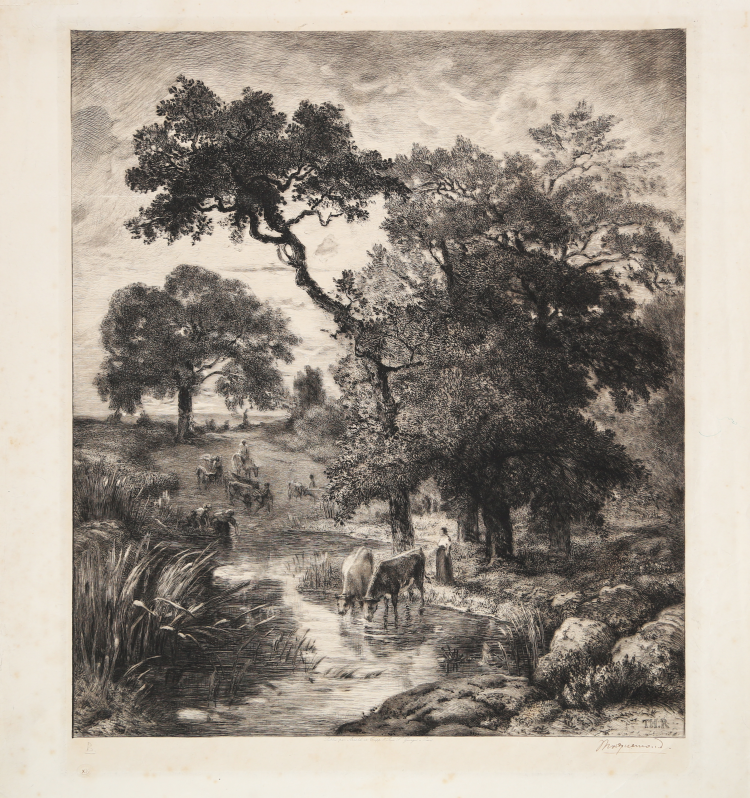



| Reference: | S6982 |
| Author | Felix BRAQUEMOND |
| Year: | 1882 |
| Measures: | 410 x 485 mm |


| Reference: | S6982 |
| Author | Felix BRAQUEMOND |
| Year: | 1882 |
| Measures: | 410 x 485 mm |
Etching and drypoint, 1882, inscribed beneath the image lower left B lower Publie par Arnold et Tripp. & Rue St Georges a Paris. In the image, lower right TH. R After a painting by Théodore Rousseau.
Example in the sixth finale state, with the signature and the publisher’s address lower centre. Etched by Félix Bracquemond (1833–1914).
Impression signed by Bracquemond, in pencil. Printsellers' Association's blind stamp at lower left.
The painting from which the etching comes is Coucher de soleil : ou, Un abreuvoir ( ca. 1850-55 ), which appeared at auction at Sotheby's . New York , 17 February 1993 , lot no . 12 , titled Coucher de soleil dans les landes prés de Begaar and which today is held in a private collection.
The Rousseau painting was the first painting by the important master purchased by the newborn gallery Arnold & Tripp gallery, which had opened in January 1881. The painting was bought from Georges Petit for 20,000 francs od 16 May 1881, and sold the following day for 26,000 francs to the Portuguese collector Pedro Eugenio Daupias. Arnold & Tripp, after having purchased and immediately sold the painting Coucher de soleil , decided to ask Bracquemond to produce a plate from which to derive copies to sell . This indicates that Arnold & Tripp had retained the reproduction rights for the painting , or at least had an agreement with the owner to that effect. The identification of the painting from which the etching comes is therefore particularly interesting because Bracquemond was not contracted to produce an engraving in order to promote the sale of the painting, which the gallery had already sold to Daupias in May 1881. Rather, as was common with artists' etchings, it was aimed at its own particular market of collector, surely interesting in having an engraving of a painting that had become part of a famous collection in Lisbon, and which they would no longer be able to admire in Paris.
Recently, in the archives of the Getty Research Institute was discovered a contract between the Parisian gallery Arnold & Tripp and the painter and etcher Felix Bracquemond (1833-1914) in order to realize a plate after a painting by Théodore Rousseau. The contract is part of a group of seven letters, contained in the Arnold & Tripp correspondance, that illustrate all the aspects of the deal, from the formal contract in July 1881 , to the various phases of the proofs, toward the final plate to be presented at the Parisian Salon of 1882. (cfr. Paolo Serafini, An Inside View of the Print Market in Paris (1881) A Contract between Félix Bracquemond and the Arnold & Tripp Gallery to Realize a Plate after Théodore Rousseau, in Getty Research Journal, n. 10 (2018), pp. 207-224).
|
H. Beraldi, tome 3, pp. 109 - 110; Paolo Serafini, An Inside View of the Print Market in Paris (1881) A Contract between Félix Bracquemond and the Arnold & Tripp Gallery to Realize a Plate after Théodore Rousseau, in “Getty Research Journal”, n. 10 (2018)
|
Felix BRAQUEMOND (Parigi 1833 – 1914)
|
Printmaker, designer, painter and writer. From a humble background, he set out on an artistic career after meeting the painter Joseph Guichard, a pupil of Ingres and Delacroix, who was to be his only teacher. He was brought up by a philanthropist friend of Auguste Comte, Dr Horace de Montègre, whose portrait he drew in pastel in 1860 (Paris, Mus. d’Orsay). Comte’s positivist philosophy was a considerable influence on Bracquemond’s aesthetic ideas. From 1852 he exhibited at the Salon both drawn and painted portraits in the style of Ingres, for example Mme Paul Meurice (Compiègne, Château), but he gave up painting after 1869.
|
|
H. Beraldi, tome 3, pp. 109 - 110; Paolo Serafini, An Inside View of the Print Market in Paris (1881) A Contract between Félix Bracquemond and the Arnold & Tripp Gallery to Realize a Plate after Théodore Rousseau, in “Getty Research Journal”, n. 10 (2018)
|
Felix BRAQUEMOND (Parigi 1833 – 1914)
|
Printmaker, designer, painter and writer. From a humble background, he set out on an artistic career after meeting the painter Joseph Guichard, a pupil of Ingres and Delacroix, who was to be his only teacher. He was brought up by a philanthropist friend of Auguste Comte, Dr Horace de Montègre, whose portrait he drew in pastel in 1860 (Paris, Mus. d’Orsay). Comte’s positivist philosophy was a considerable influence on Bracquemond’s aesthetic ideas. From 1852 he exhibited at the Salon both drawn and painted portraits in the style of Ingres, for example Mme Paul Meurice (Compiègne, Château), but he gave up painting after 1869.
|